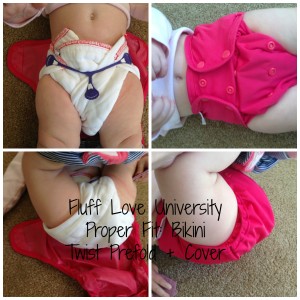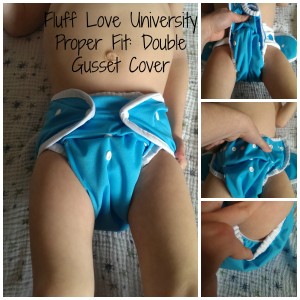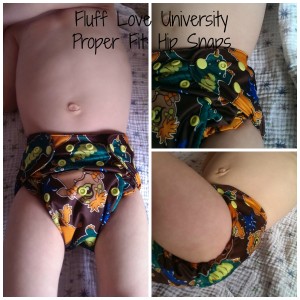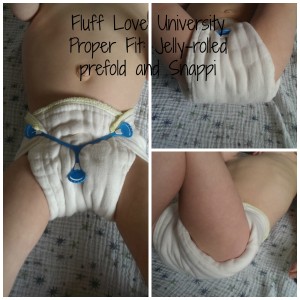Home >> Troubleshooting >> What to Do About Leaking Diapers
Having trouble with your cloth diapers leaking? Can’t keep the onesies dry when your little one wears his cloth around? Leaking is one of the most common – and most frustrating – cloth diaper challenges. Just like many parents find that one brand of disposable diapers works better than another, so too will parents of cloth diapered babies run into fit and leaking challenges. Here, we will explain some of the common causes of leaks and how to fix them!
The most common cause of leaks is improper fit. Always check fit FIRST!
As your baby grows, they will change shape and size dramatically. While your chunky infant may have been on the second rise snap and had two open snaps on the waist, the moment they start walking you may see them drop to the first rise and need their diapers significantly tightened up. Elastics on diapers relax over time, and different brands fit differently.
Generally speaking, diapers should fit
- snug around the waist, but not over-tight
- with no gaps around the legs
- higher up on the waist than adult underwear sits – you want to lay flats and prefolds even with the belly button when you’re putting them on
- in the “underwear cracks” on the legs – not around the knees, not between the legs, but in the indentation between the crotch and knee
If you are having issues, check:
- Are there leg gaps?
- Too loose around the waist?
- Is there a belly gap?
- Is the diaper set to the correct rise snaps?
- Could the diaper be too tight and causing compression leaks? (see below)
For a visual guide, check out the proper fit pics below. Remember the general rules – there should be no gaps at the leg, the diaper should be snug around the waist, prefolds/flats/fitteds/inserts should not “stick out” of the diaper. Click the pictures to enlarge!
Compression Leaks
Although diapers commonly leak because they are too loose, being too tight can be equally problematic. Diapers should be snug, but not over-tight around the waist, and double- and triple-stuffing can cause excess bulk that, in turn, will either force leg gaps or cause compression leaks.
Compression leaks:
- most commonly happen with microfiber inserts
- happen more often in older children who are putting more pressure on the diaper (as by sitting on it or simply by weighing more)
- often occur because a diaper is over-stuffed
- can be caused by outside, non-diaper forces, such as the crotch buckle of a swing or car seat or overly tight pants
If compression leaks are a problem, adjust the fit so the diaper is snug but not tight, evaluate your stuffing routine for pockets, and if possible, allow for looser clothing to accommodate the fluff butt.
If you continue to have fit issues despite all the adjustments in the world, sometimes you will find that (just like disposables) a certain brand or style of diaper doesn’t work for you. For this reason, we always recommend trying several different brands or types when building your “stash,” rather than just jumping into all one type.
Absorbency issues
Cloth diapers don’t absorb as much liquid as modern disposable diapers, which can sometimes result in leaks because the diaper simply can’t contain any more liquid. If you’re having issues with leaks and the fit looks good, check these things:
Are the inserts saturated?
If the inserts or diapers you’re using are completely soaked, you may need to change the diaper more often or add more absorbency. Cloth diapers should be changed, generally speaking, every 2-3 hours. Some “heavy wetters” and especially some older babies (who are beginning to “hold it” for longer before wetting the diaper) can soak through a basic insert combination easily, and will need additional inserts or boosters added to the diaper.
If the inserts are fully saturated and you’re changing the diapers frequently enough, consider adding additional inserts or changing the materials you’re using.
Fiber Facts
- Most pocket diapers come with microfiber inserts. Microfiber absorbs quickly and is very efficient at pulling moisture away, but it is also prone to compression leaks and cannot hold as much liquid as other fibers.
- Cotton is another excellent choice for an absorbent natural fiber. It is not quite as absorbent as bamboo or hemp, but far less expensive. Many moms find success with wrapping their microfiber inserts with flour sack towels to provide a boost in absorbency without spending a whole lot of money.
- Bamboo is a good medium between the super-absorbent hemp and quick-absorbing microfiber, and it is also super soft. It is more expensive than cotton, but not as much as hemp.
- Hemp is slower to absorb than microfiber, but holds far more liquid
| Speed of absorbency | Amount of absorbency | Cost | |
| Microfiber | Your kid when you turn your back | Amount of milk leftover in the Froot Loops bowl | Comes with the diapers |
| Cotton | Cheetah | Amount of juice your toddler would drink if you’d let him | $1 at Walmart |
| Bamboo | Bunny rabbit | Amount of water on the floor after your crawler finds the dog bowl | You can totally justify that. |
| Hemp | You before coffee | Amount of coffee you need to function | Well, at least it’s not a Tula? |
Are the inserts saturated in one place, but dry elsewhere? (Flooding)
“Flooding” can happen when an insert gets more liquid than it can take in and distribute at one time. This can be because you’re using a slow-absorbing insert (such as hemp) and a lot of liquid is entering the diaper at once, or it can be a “positional” problem, where the absorbency is not in the right place. One specific characteristic of flooding is that it tends to appear suddenly, as your baby might suddenly start holding their urine for longer before “going” all at once. It also tends to happen at night, when the sheets are soaked but the diaper is dry, especially if you have a tummy- or side-sleeper.
Add more absorbency in the “problem area”
Many AIOs or pocket inserts allow the absorbency to be “balanced” to the front or back, which can help you put more absorbent material where it needs to go. BumGenius Elementals, for example, contain a soaker that is longer than the PUL outer, requiring it to be folded back on itself before it can be snapped onto baby. If you’re noticing your diapers are leaking through the front, you might try balancing this fold in the front so there is more absorbency where it needs to be. The Grovia O.N.E. has two soakers that snap together, and the long “tongue” can be folded to place more material at the front or back. Similarly, pocket diaper inserts that “snap down” to a smaller size can be flipped around to put additional absorbency where it is needed.
If you are using flats or prefold diapers, consider using a different fold that will place more absorbency in the area where you need it. Typically, boys need more absorbency up front, and girls need more absorbency towards the middle. Babies who are close to sitting up but not quite there yet may need more absorbency in the back. Also, with boys, it is important to remember to keep the penis pointed down, or urine can flood right out of the top of the diaper without ever hitting the absorbent portion at all!
Overnight leaks with side or belly sleepers
Another “positional absorbency” problem comes with side or belly sleepers. Pocket and AIO diapers typically only have a “strip” of absorbency through the middle, and when a baby sleeps on their side or belly, gravity can cause urine to run straight down out the side of the diaper – and onto the bed sheets – before it ever gets to the absorbent portion of the diaper. In this case, using flats, prefolds, or fitteds can help, because the diapers are absorbent “all over” instead of just through the middle.
Point it down!
Many parents run into leaking issues with their boys when the urine comes out in an inappropriate direction and “misses” the absorbency. This is especially a problem with leaks at the waist or belly. If you are having leaks with a boy, make sure the penis is pointed down when you snap the diaper on. Of course we know that can change, especially with a curious toddler, but it’s always good practice to make sure things start out pointing the right direction.
Are your diapers repelling?
Diapers washed with improper routines or when fabric softener or diaper creams are used may begin to repel liquids instead of absorbing them. This happens when something that does not allow the water to pass through into the fabric builds up on the surface of the insert, causing the water to bead up like rain on a duck’s back. If your diapers leak and the inserts aren’t soaked, repelling might be the issue.
Test the absorbency
Drop a small amount of water onto the insert of your diapers – about a tablespoon will do! Use your fingers to apply a bit of pressure to the water to kind of push it into the fabric. If the water just beads up and slides away, you’ve got a repelling issue! If the water soaks in, however, the problem lies somewhere else. Remember that you do need to apply some pressure to the liquid (a baby doesn’t neatly and gently pour a tablespoon of water onto the inserts while they’re wearing the diaper, right?), especially if you are testing microfiber.
Has a non-CD safe cream been used?
Diaper creams containing petroleum or petrolatum are the number one culprit of repelling. If you or another caregiver accidentally slathers up baby with Desitin, Aquaphor, Vaseline, or any other petroleum-based cream, you’ll need to remove the petroleum before the diaper will absorb properly again.
Natural fibers such as hemp and cotton can often be washed on hot with a good strong detergent and come out just fine, regardless of what type of diaper cream was used. Synthetics, such as microfiber or anything with a “stay dry” layer, will need to have more drastic measures taken to get rid of the gunk.
Remove petroleum based creams with a degreaser and some good ol’ fashioned scrubbing with a toothbrush. Dish soap, such as Dawn, is a popular choice for doing this, but remember that you will need to very thoroughly rinse the diaper after the cream is removed before tossing it in the washing machine.
Wash Routine Issues
Soap Scum buildup
If you’ve been using a detergent such as All Free Clear Liquid or any other detergent containing soap or saponified coconut oil as the primary surfactant (Ecos, Zum Clean, and Ecover Liquid all contain this ingredient as the primary cleaning agent; see our Detergent Index for more information), homemade “detergent” containing grated bar soap, or Soap Nuts, your diapers may be repelling due to a build up of soap scum on the fibers. Soap is made of oils, and those oils do not often rinse cleanly away in modern washing machines. When the oils are left behind on fabrics, the fabric can become water-repelling – which isn’t good for diapers!
Mineral buildup
Diapers washed repeatedly in untreated hard water or washed with many extra rinses can become saturated with minerals to the point that mineral buildup will cause repelling and leaks. This really only happens in very hard water, or over a great long period of time – however, it is definitely a possibility!
If you have soap scum or mineral buildup to the point that your diapers are repelling, it’s time to strip and bleach!
Leaks “through the PUL”
If your diapers are leaking straight through the outer PUL layer, you’re dealing with the most frustrating kind of leaks because the cause can be difficult to identify. Unfortunately, this may mean your diapers have reached the end of their lifespan, but it may also be a much simpler issue, so it is important to investigate all possibilities before buying a whole new stash!
Check the PUL for cracks and delamination
If possible, flip your diaper inside out and thoroughly inspect the PUL for cracks, delamination, or any other oddities. Delamination looks like the plastic layer is pulling away from the fabric layer.
If your diapers are AIOs without accessible PUL, such as Grovia AIOs or Old-style BumGenius Elemental, you can test the PUL by pouring a small amount of water (a couple of tablespoons) onto the diaper and checking to see if it seeps through the other side. Keep in mind, however, that PUL is water-resistant, not water-proof, and adding excessive water will cause any diaper to leak.
PUL is water-RESISTANT, not water-PROOF.
Keep in mind that PUL is not made to be a complete barrier like old-school rubber pants. Instead, PUL is breathable, and as such, it is not completely impermeable. Enough liquid in a strong enough stream can force its way through the PUL – try taking a ketchup or peri bottle and squeezing it right at the PUL of a diaper at close range. You will notice that the diaper gets wet on the outside, even though you were spraying the “waterproof” part.
If you find that your diapers are leaking straight through the PUL and the insert is partially saturated, you may have a case of flooding. This is often the case with boys. If this is the case, check out the tips above for dealing with flooding by balancing the absorbency differently. And with boys, of course, don’t forget to point it down!
Wicking
“Wicking” occurs when an absorbent fabric touches something wet and begins to absorb that moisture. Imagine dipping the corner of a paper towel into a glass of water – you would quickly see the water drawn up through the paper towel, even though only a small portion is actually in the water. This can happen with anything made of absorbent fabric, including cotton onesies, baby blankets, shopping cart or high chair covers, and mom’s pants.
Why does wicking occur?
Typically, wicking occurs in one of three ways:
- In conjunction with fit issues
- When clothing interferes with the diaper
- When absorbent fabric is placed over wool
Fit issues
Wicking due to fit issues happens when the PUL of a diaper “rolls” in on the absorbent part, exposing the soaker or liner to the outside. This can happen at the legs or belly, but is uncommon on the back of the diaper. In many cases, if a diaper is put on correctly (see the photos and diagrams above) but still rolls in and causes wicking as soon as baby moves, you have unfortunately found a diaper style that doesn’t work for your little one. Sometimes using clothing over the diapers can help hold them in place, but just as often this can exacerbate the problem by exposing more absorbent fabric to the wetness inside the diaper.
Clothing interference
When a onesie is worn over a cloth diaper, often the leg holes of the onesie line up perfectly with the leg holes of the diaper. If the edging of the onesie manages to creep under the edge of the diaper as baby wiggles about, the onesie can come in contact with absorbent fabric and start to wick moisture. In this case, it’s usually the fit of the onesie that needs to be adjusted. Onesie extenders can be helpful in making them fit correctly over cloth bums, and of course it is always an option to ditch the onesie entirely and dress your little in dresses, T-shirts, and pants. “Maxaloones” and Project Pomona are two types of pants specifically made for cloth diapers; additionally, many parents find success simply sizing up in pants.
Another option is using baby leggings, the long socks that cover baby’s entire leg from foot to hip. These are great non-pants, but care should be taken not to accidentally pull them too high and tuck them underneath the diaper, or you will end up with the exact same leaking problems you started with!
Wicking and Wool
Wool is an amazing fiber that can hold up to 1/3 of its own weight in liquid without feeling wet to the touch. This, combined with its superior breathability, makes wool an almost-ideal diaper fabric. However, one flaw with wool is that wool needs to be the outermost layer. If any absorbent fabric is placed over wool, any liquid the wool absorbs can, in turn, be absorbed by the clothing that sits on top of it. If you are using a wool diaper cover, make sure it is the top layer with nothing worn over it. Wool “longies” are a great winter option. An exception to this rule is fleece, which is itself water resistant. Fleece pants may be worn over wool with no adverse affects.






